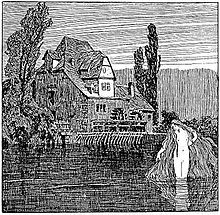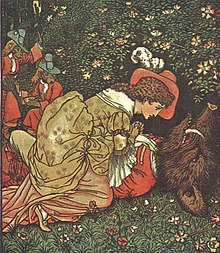Fairy tale
Fairy tales are known as folk tales in many European countries and fairy tale traditions. In the 18th and 19th centuries, they were a popular theme in art fairy tales , especially in France.

Folk tales
Fairies or elves in folk tales and folk legends are beings from an otherworld , who show themselves to people under certain conditions and intervene in people's lives, for better or for worse . They live in a world of their own, sometimes referred to as the underworld. In the different regions there are different names such as the good or quiet people in Ireland , the Huldren in Iceland , the samovils or samodives in Eastern European countries.
The Brothers Grimm presented their first collection with the Irish fairy tales, which they published for the first time in 1862 under the title "Irish fairy tales".
Frederik Hetmann described the Celtic fairy world, which includes the countries / regions Ireland, England , Scotland , the Shetland Islands , Wales , Brittany , Austria , Switzerland , South Tyrol and Italy . The different names of the other world they inhabit characterize at the same time what is different there than in the human world, such as eternal youth, the blessed, hope, promise, female rule. As in this world, there are trees, bushes and animals in this other world that are similar to the human world, but which often take on a magical, enchanted character. There are men, women and children who also pursue similar activities in their world as humans. However, some activities are more important, such as making music and dancing, and there are also activities of magic , which can sometimes also include healing arts. By designating the human world as that of mortals, the immortality of the fairies is illustrated.
People can get into the fairy world through objects or through trance states . Often the time relationships shift: a short time in the fairy world turns out to be a much longer one after returning to the human world. In other narratives, humans do not survive their stay in the fairy world or they crumble to ashes when they return. The ambivalence towards the fairy world is evident in the tension between seduction and danger.
Hetmann typifies the fairy tales according to the characteristics that fairies help mortals , harm them , kidnap them for specific purposes , the motif of the mortals' visit to the otherworld and the fairy tales that revolve around the theme of the changeling . This means children who are foisted on people. Another motive is the marriage between a (mostly male) person and a (mostly female) fairy, whereby it is different whether that turns out good or bad. Sometimes this causes the fairies to lose their immortality. Hetmann assumes that the features and motifs of the Celtic fairy tales also appear in those of other countries and regions.
In the volume about the Otherworld, first published in 1981, Hetmann himself presented a collection of 94 stories from Ireland, which go into the area of legends and myths: from the earliest testimonies about the Otherworld, the various fairies, their goings-on in the Otherworld and in that is enough for people, a calendar through which you can find out what can happen to you at certain times in the fairy world up to trips to the islands of the blessed and eternal youth and stories of love and death.
The collection of fairy tales by Sabine Lutkat covers a wider geographical area with various European fairy tales. It essentially comprises folk tales, some in literary adaptation, as they were made more frequently in the context of their recording. Examples of the different motifs are two fairy tales in which fairies as women of fate decide the length of a person's life: The Romanian fairy tale The Prince and the Three Fairies and a fairy tale from the Balkans Envy between sisters . Ten of the recorded fairy tales show the motif dedicated to helpful, grateful or punishing fairies . The best known is the Irish fairy tale O'Donoghue's bagpipes from the collection The Harp of Erin by Julius Rodenberg , in which a blind, mostly drunk bagpiper brings a special bagpipe from his visit to the fairies into the unearthly world. Another group is the theme The fairies and love with eight fairy tales, u. a. The Elven Queen Hild from Iceland , The Shepherd and the three Samodives from the Balkans and The Harmonica from Scandinavia . Further topics are fairy tales, which deal with typical fairy things and aspects such as the fairy ring , a fairy place that goes unnoticed and one can unexpectedly come across, the connection of good gifts with taboos linked to them, or the fairies' preference for human children , the use of human wet nurses for fairy children and the motif of the changeling.
In the context of the music fairy tale, Rosemarie Tüpker emphasizes the closeness of fairies to music: On the one hand, the music, in addition to or combined with the intoxication , is more often the possibility of the transition of a human protagonist into the fairy world; on the other hand, the protagonists who are in the Stop the fairy world, make the subterranean ones weighed by making good music. Sometimes they receive a reward for this, for example the healing of an ailment or a particularly good musical instrument.
The changeling can also often be recognized by the fact that they have a special penchant for music and have a special gift in making music as a child. A large variety of musical instruments that are popular with fairies appear: flutes , harmonica , jew's harp , bagpipes, harp , shawm , but also singing, the sound of bells or melodies resounding by animals.
Also in a collection by Wolfgang Laade there are unearthly musicians , sea minnows, elves and mermaids in fairy tales, but also local legends.
Art fairy tale

Fairy tales are also a popular genre among art fairy tales . In the process, traditional material is often freely transferred into modern times and enriched with psychological codes and other aspects, sometimes with reflections on moral content.
In France in the 17th and 18th centuries, fairy tales were very popular as amusement among the nobility. They represented a combination of oriental legends and their own real experiences. The most important French authors are Charles Perrault , Antoine Galland - who translated the Arabian Nights -, Catherine d'Aulnoy, Henriette-Julie de Castelnau, comtesse de Murat and, in the 19th century , Sophie de Ségur . The most excellent fairy tales can be found in the Cabinet des Fées by Charles-Joseph Mayer (41 volumes, Paris 1785–89). Christoph Martin Wieland is known by German authors for fairy stories and their criticism.
Theater, opera, film
In the literary genre of Feerie (also: Féerie, French for 'magic world'), also known as magic piece in German , fairy tales serve as material for the use of complex stage technology that allows magic to be brought to the stage.
In the old Viennese folk comedy , the dramatized French fairy tales played an important role and reached their climax in the early magical antics of Ferdinand Raimund . By cleverly combining everyday social life with fairytale magic, it was possible to revive the old magical farce.
In the field of opera there are u. a. the work Feenmärchen, op. 312 (1866) by Johann Strauss (son) and Die Feen (1888) by Richard Wagner.
The Disney production Tinker Bell with music by Joel McNeely was released in 2008 as a modern fairy tale . It was continued with annual productions and dubbed into several languages.
An example of multiple use is the well-known fairy tale Beauty and the Beast .
Individual evidence
- ↑ Klaus Hammer (Ed.): French fairy tales of the 18th century. Parkland-Verlag, Stuttgart 1980, ISBN 3-880-59145-8 .
- ↑ Sabine Lutkat (ed.): Fairy tales to tell and read aloud. Krummwisch near Kiel: Königsfurt-Verlag , 2007, ISBN 978-3-89875-191-9 , pp. 7-10.
- ↑ Irish fairy tales. In the broadcast by the Brothers Grimm. Friedrich Fleischer, Leipzig 1826
- ↑ Frederik Hetmann (ed.): Celtic fairy tales. For storytelling and reading. Königsfurt-Urania, Krummwisch near Kiel 2013² ISBN 978-3-86826-048-9
- ↑ Frederik Hetman: Experience and understand fairy tales and interpretation of fairy tales. Krummwisch near Kiel: Königsfurt-Verlag, 1999, ISBN 978-3-933939-02-9 , pp. 91-112.
- ↑ Frederik Hetmann: The journey into the other world: fairy tales and fairy stories from Ireland. Königsfurt-Urania Verlag, Krummwisch bei Kiel, new edition 2005 ISBN 978-3-89875-129-2 (first edition 1981)
- ↑ Rosemarie Tüpker: Music in fairy tales. Wiesbaden: Reichert-Verlag , Wiesbaden 2011, ISBN 978-3895-00839-9 , pp. 205-224.
- ↑ Wolfgang Laade: Music and musicians in fairy tales, sagas and anecdotes of the peoples of Europe: A collection of sources on the problem of music as culture. Körner-Verlag, Baden-Baden, 1988
- ↑ Jens Tismar: Kunstmärchen (Metzler Collection; 155) 2nd edition Metzler, Stuttgart 1983. ISBN 3-476-12155-0 , pp. 12-22.